Patra
Patras is the third largest city in Greece. Located 216 kilometers west of Athens at the foot of the Panachaic Mountains, it is surrounded by the Gulf of Patras. It is the capital of the Prefecture of Achaia, the region of Western Greece and the largest urban center and port of the Peloponnese.
During the four millennia of its history, and especially in the Roman period, Patras was the cosmopolitan center of the Mediterranean, and according to Christian tradition it is the site of St. Andrew’s martyrdom.
Called the Greek Gate to the West, it is an international trade center, a major port and a hub for trade and communication with Italy and the European West The state-of-the-art Rio-Antirio bridge connects Patras Rio’s suburb with Antirrio, joining it Peloponnese with Central Greece. In addition, the city boasts of its largest European, Mediterranean-style carnival, the famous Patriotic Carnival, whose main features are its huge satirical chariots and spectacular dances and parades. The most common explanation given for the name of the city is the mythological one, that is, it comes from Patras, the mythical settler of the city.
It is one of the first cities to revolt against the Turks in 1821. It was almost completely destroyed during the revolutionary struggle. The modern city was built by Kapodistrias in the ancient site.
Saint Andrew
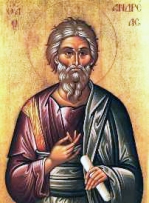 Saint Andrew Was the first student of the 12 who was called to the Apostolic office and was therefore called “Protokolitos”. He and his brother Peter were born in the town of Galilee Bethsaida.
Saint Andrew Was the first student of the 12 who was called to the Apostolic office and was therefore called “Protokolitos”. He and his brother Peter were born in the town of Galilee Bethsaida.
On September 26, 1964, after 504 years, Cara of St. Andrew returned to Patras. Today the Apostle Andrew’s Kara is kept in the New Holy Temple.
In addition to Agia Cara, in the Old Church of St. Andrew is kept a small piece of Saint’s finger, donated in 1847 to the church by the Russian patriarch Muraviev, who had acquired it during his visit to the shrine of St. Andrew of Mount Athos.
Saint Andrew is the only one of the Apostles who testified in the city of Patras.
Old Church
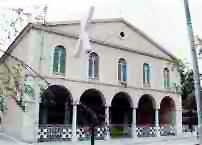 It was built between 1836-1843 at the place where Apostle Andreas testified. It was built between 1836-1843 at the place where Apostle Andreas testified. Inside is a three-aisled basilica, designed by architect L. Kaftatzoglou. He is frescoed with elaborate and rare paintings by the Ionian School, most of which are works by the great Constantinople icon painter and author D. Byzantium.
It was built between 1836-1843 at the place where Apostle Andreas testified. It was built between 1836-1843 at the place where Apostle Andreas testified. Inside is a three-aisled basilica, designed by architect L. Kaftatzoglou. He is frescoed with elaborate and rare paintings by the Ionian School, most of which are works by the great Constantinople icon painter and author D. Byzantium.
New Church
 The new church was founded on June 1, 1908 by the King of the Greeks George I. The church was officially inaugurated on September 26, 1974, ten years after the Holy Apostle’s re-commission. Predictable are the mosaics that have been built to date and with original themes. It is Greece’s largest temple of about 2,000 sq.m. and together with the women there are about 8,000 people.
The new church was founded on June 1, 1908 by the King of the Greeks George I. The church was officially inaugurated on September 26, 1974, ten years after the Holy Apostle’s re-commission. Predictable are the mosaics that have been built to date and with original themes. It is Greece’s largest temple of about 2,000 sq.m. and together with the women there are about 8,000 people.
THE HOLY SPIRIT
To the right of the old Temple, there is a fountain with 11 steps down. The fountain is very old and was part of Dimitra’s oracle.
Roman Conservatory
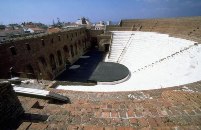 In the upper town is the Roman Conservatory of Patras, erected earlier by the Conservatory of Athens (Herodion, 160 AD). The Conservatory came to light in 1889, when excavations were made on the hill to excavate the harbor. Its restoration was completed in 1956. In the same decade, the surrounding area was transformed into an archaeological site, with an exhibition of ancient findings. The Conservatory has all the essential parts of a theater, while its 23 seating rows can accommodate 2,300 spectators. The Ancient Conservatory is the main seat of the International Festival of Patras, hosting large bands and performances.
In the upper town is the Roman Conservatory of Patras, erected earlier by the Conservatory of Athens (Herodion, 160 AD). The Conservatory came to light in 1889, when excavations were made on the hill to excavate the harbor. Its restoration was completed in 1956. In the same decade, the surrounding area was transformed into an archaeological site, with an exhibition of ancient findings. The Conservatory has all the essential parts of a theater, while its 23 seating rows can accommodate 2,300 spectators. The Ancient Conservatory is the main seat of the International Festival of Patras, hosting large bands and performances.
Apollo Theater
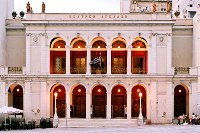 The Apollo Theater was built in 1872 by the designs of the great German architect Ernesto Ziller. It is a miniature of the Scala of Milan and is one of the oldest surviving closed theaters of modern times and the most impressive architectural ornament of Patras. Its interior includes the square with 156 seats and 53 two-story theaters. Its tent is 13.5 meters wide and 7.5 meters deep.
The Apollo Theater was built in 1872 by the designs of the great German architect Ernesto Ziller. It is a miniature of the Scala of Milan and is one of the oldest surviving closed theaters of modern times and the most impressive architectural ornament of Patras. Its interior includes the square with 156 seats and 53 two-story theaters. Its tent is 13.5 meters wide and 7.5 meters deep.
Achaia Clauss
 In 1854, Gustavos Klaus bought a plot of land in the area of Petrotos, outside Patras, at an altitude of 500 meters, overlooking the entire city, and there built a standard residential and business complex. The headquarters of Achaia Clauss, which was designed and built on the basis of northern European architectural trends of the time, housed the offices, the winery, the cellars and the houses of the company’s employees. The world-famous sweet wine Mavrodaphne and the label “Demesticha”, the first Greek bottled wine, belong to Achaia Clauss. According to tradition, Klaus named Mavrodaphne so as to remember his suitor named Daphne – a brunette beauty of the era who died at an early age
In 1854, Gustavos Klaus bought a plot of land in the area of Petrotos, outside Patras, at an altitude of 500 meters, overlooking the entire city, and there built a standard residential and business complex. The headquarters of Achaia Clauss, which was designed and built on the basis of northern European architectural trends of the time, housed the offices, the winery, the cellars and the houses of the company’s employees. The world-famous sweet wine Mavrodaphne and the label “Demesticha”, the first Greek bottled wine, belong to Achaia Clauss. According to tradition, Klaus named Mavrodaphne so as to remember his suitor named Daphne – a brunette beauty of the era who died at an early age
Castle or Rio
It was built in 1499 by Vayazit II to control the little Dardanelles as they called the sea passage. It was captured by the Spaniards and the Genoese and by the Turks and surrendered in 1928 to the French General Maison.
Rion – Anirion Bridge
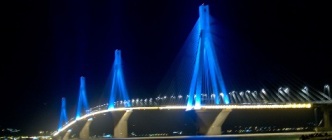 The largest cableway bridge in the world, 2250 meters long, was launched in 2004 and united Western Greece. A symbol of 21st century Greece, the Rio-Antirio Bridge, inspired by Messolonghi Prime Minister Charilaos Trikoupis, whose name bears the historical longing of generations and generations of Greeks.
The largest cableway bridge in the world, 2250 meters long, was launched in 2004 and united Western Greece. A symbol of 21st century Greece, the Rio-Antirio Bridge, inspired by Messolonghi Prime Minister Charilaos Trikoupis, whose name bears the historical longing of generations and generations of Greeks.
The New Museum
The exhibits guide the public in the history of Patras from prehistoric times to the late Roman times. The exhibition is divided into three thematic sections in three rooms of the Museum. This is the Private Life Room, the Necropolis Room and the Public Life Room. The first two are open to the public and the third will be delivered next fall.
Highway Patras Athens & America Tel +30 2610 420645.
Open daily (except Mondays) 08.30-15.00
Carnival
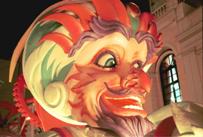 The Patras Carnival is the largest carnival event in Greece. It measures 160 years of history. The Patras Carnival is not just a specific event but a set of events that include dances, parades, hidden treasure hunts, carnival of the little ones and more. It culminates in the last Carnival weekend with the Saturday Night Crawl Parade of Paradise, the spectacular Sunday Parade of Crews and Crews, and finally the ritual burning of King Carnival at Agios Nikolaos’s mausoleum. Typical principles are spontaneity, improvisation, source inspiration and volunteering.
The Patras Carnival is the largest carnival event in Greece. It measures 160 years of history. The Patras Carnival is not just a specific event but a set of events that include dances, parades, hidden treasure hunts, carnival of the little ones and more. It culminates in the last Carnival weekend with the Saturday Night Crawl Parade of Paradise, the spectacular Sunday Parade of Crews and Crews, and finally the ritual burning of King Carnival at Agios Nikolaos’s mausoleum. Typical principles are spontaneity, improvisation, source inspiration and volunteering.


